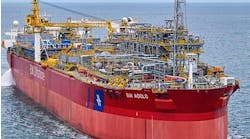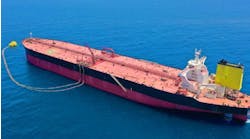Gene Kliewer • Houston
PGS contracts additional seismic vessel
Petroleum Geo-Services ASA has exercised its option with Aker Yards to buildRamform 8 seismic vessel for delivery in 2Q09.
The 3D seismic acquisition vessel will be able to tow 22 streamers and technology improvements will increase efficiency in handling, deployment, retrieval, and maintenance.
Aker currently is buildingRamform 7 for PGS.
This new Ramform class seismic vessel is a sister vessel of the previously announcedRamform 7, which is currently being built at the same yard. Ramform 8 has an agreed cost from the yard including installation, but excluding the cost of seismic equipment, of approximately $88 million. The vessel is scheduled for delivery in 2Q09.
The third generation Ramform is designed to extend PGS’ 3D seismic acquisition productivity and efficiency. The design builds on the proven capabilities of the current Ramform fleet, while introducing several improvements. Compared to the existing Ramform vessels, the vessel is approximately 16 m longer, giving higher fuel capacity and transit speed. A substantial power upgrade will increase speed while surveying.
The vessel will be capable of towing up to 22 streamers. A range of technology improvements will be implemented to maintain or improve efficiency of handling, deployment, retrieval, and maintenance of the in-sea equipment.
PGS president and CEO, Svein Rennemo, said: “The strategic rationale for this investment is to further enhance PGS’ productivity leadership in towed streamer acquisition, in general, and in advanced towed streamer acquisition, in particular. We expect demand for marine seismic services to be very strong over the next years. Although significant additional capacity will come into the industry we believe that demand fundamentals longer term will support advanced high productivity capacity like the new generation Ramforms.”
Arrow, Western Geco agree on newbuild vessel
Arrow Seismic ASA has signed a non-binding LOI with WesternGeco for a multistreamer seismic newbuild vessel to be delivered in November 2008. The LOI includes an agreement to enter into a five-year charter for the vessel, including insea seismic equipment.
Trinidad leasing schedule slips
Trinidad & Tobago’s energy ministry has extended its deadline to submit offers for the current hydrocarbons bid round. The deadline for the onshore, near shore, and shallow-marine blocks slipped to Oct. 31 from Aug. 28. Winners are scheduled to be announced Jan. 2, 2007.
Offers for eight deepwater blocks slipped further and now are due Nov. 30 rather than Aug. 28. Those winners are to be announced Feb. 1, 2007. Twelve companies have inquired about these blocks. The eight blocks range from 79,947-84,155 ha and are off the east coast.
Companies that submitted pre-bid applications include: Amerada Hess; Apache; BG; BHP Billiton Petroleum; Centrica; Challenger Energy; Canadian Superior Energy; Canadian Voyager; Eni; EOG; Exxon Mobil; Hardman Resources/Hardman Oil & Gas; Husky Energy International; Kerr-McGee; TT Offshore Petroleum; Mitsubishi Energy; Mittal Steel; NewMarc Petroleum Associates; Nippon Oil; Petrobras Energia Venezuela; PetroCanada; Petronas; Repsol YPF; Statoil; Talisman; TED; and Ten Degrees North Energy, according to ministry documentation.
The eight onshore/nearshore blocks include shallow and deep horizon areas in each of the Guayaguayare (2,329 sq km), Southwest Peninsula (1,455 sq km), Herrera (953 sq km), and Central Range (1,590 sq km) blocks.
The shallow marine blocks are 2(ab) covering 1,605 sq km and NCMA 2 and NCMA 3, which each cover 1,019 sq km. The three blocks have water depths ranging from 25-130 m.
Fugro-Jason releases Jason Geoscience Workbench 7.2
Fugro-Jason has released a new version of Jason Geoscience Workbench (JGW). This release - Version 7.2 - helps produce a single, consistent model of the earth for use across the E&P spectrum of activities. It includes 3D seismic inversion, interactive well tying, wavelet estimation, geostatistical inversion, AVA simultaneous inversion, rock physics, petrophysics, reservoir modeling, and advanced analysis and 3D visualization.
“This latest release of the Jason Geoscience Workbench reflects our commitment to continually improve the quality and efficiency of reservoir characterization,” said Eric Adams, managing director of Fugro-Jason. “The new release incorporates direct feedback from our customers and services staff, and is aimed at enhancing and streamlining the E&P workflow.”
The release introduces a new model builder, EarthModel FT, plus new modules 3D grid/CPG Builder and RockScale, for constructing simulation-ready grids and for upscaling JGW inversion results into those grids. EarthModel FT, 3D grid/CPG Builder and RockScale are built on the FastTracker technology acquired in 2003, and include the UpdateAbility functionality which makes incorporation of new data simpler. The 7.2 version of existing modules contains several productivity enhancements, greater control in operations, and expanded functionality.
“We work hard to ensure that JGW has the capabilities that our customers need,” said Frank Vintges, Application Engineering manager. “Release 7.2 is the result of input we actively solicited and received from oil and gas companies around the world.”
Fugro metocean contract with India
A contract for metocean monitoring off both the east and west coasts of India was awarded to Fugro Survey (India) PL and Fugro GEOS by Reliance Industries Ltd.
The contract covers meteorological and current profile measurements from rigs operating offshore. The data will be used in real-time for operations and analyzed for design criteria.
The two-year contract is for one rig in 3,000 m of water and two in about 600 m. The drillshipDeepwater Frontier will be used for the deeper project which starts this month.
During the first phase of measurements at 3,000 m depths, the rig will be fitted with a met station for measurement of atmospheric parameters in real-time and a custom-made gantry, for ADCP (Acoustic Doppler Current Profiler) deployment and support. A downward-looking 38 kHz ADCP will profile the first 1,000 m, while an upward facing seabed-mounted ADCP will profile the lower 500 m.
A horizontal ADCP will provide far field near-surface water currents and directional waves unaffected by the rig. An ROV mounted ADCP will provide current profiles in real-time over the full ocean depth to 3,000 m.
Data from all instruments will be displayed and stored on PC’s onboard the drillship running Fugro GEOS software.
The second phase of measurements at 600 m depths includes downward-looking ADCPs with horizontal ADCPs measuring currents and waves, and has met stations aboard the rigs.
The initial contract covers carrying out observations for two years on three rigs; with the possibility of a contract extension of up to three more years on a further four rigs.


